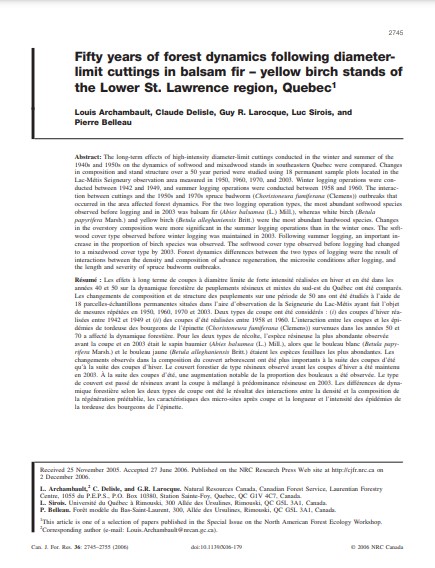Fifty years of forest dynamics following diameter-limit cuttings in balsam fir–yellow birch stands of the Lower St. Lawrence region, Quebec
Bosque Modelo:
Bas-Saint-Laurent
Temática:
Gestión forestal
Tipo de documento:
Artículo científico
Resumen
The long-term effects of high-intensity diameter-limit cuttings conducted in the winter and summer of the 1940s and 1950s on the dynamics of softwood and mixedwood stands in southeastern Quebec were compared. Changes in composition and stand structure over a 50 year period were studied using 18 permanent sample plots located in the Lac-Métis Seigneury observation area measured in 1950, 1960, 1970, and 2003. Winter logging operations were con- ducted between 1942 and 1949, and summer logging operations were conducted between 1958 and 1960. The interac- tion between cuttings and the 1950s and 1970s spruce budworm (Choristoneura fumiferana (Clemens)) outbreaks that occurred in the area affected forest dynamics. For the two logging operation types, the most abundant softwood species observed before logging and in 2003 was balsam fir (Abies balsamea (L.) Mill.), whereas white birch (Betula papyrifera Marsh.) and yellow birch (Betula alleghaniensis Britt.) were the most abundant hardwood species. Changes in the overstory composition were more significant in the summer logging operations than in the winter ones. The soft- wood cover type observed before winter logging was maintained in 2003. Following summer logging, an important in- crease in the proportion of birch species was observed. The softwood cover type observed before logging had changed to a mixedwood cover type by 2003. Forest dynamics differences between the two types of logging were the result of interactions between the density and composition of advance regeneration, the microsite conditions after logging, and the length and severity of spruce budworm outbreaks.
Información Bibliográfica
Autor:
Archambault, L, C Delisle, GR Larocque, L Sirois and P Belleau.
Revista:
Canadian Journal of Forest Research
Año:
2006
N°:
-
País :
Canadá
Páginas:
2745 - 2755
Volumen:
36
Idioma:
Ingles
Palabras claves
Model forest, Adaptatation





